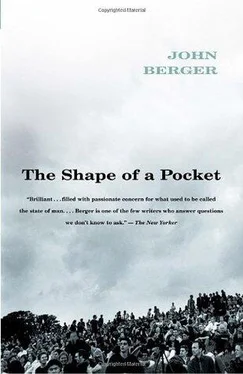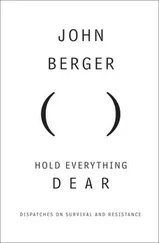The Holy Family (Munich). The Virgin is seated in Joseph’s workshop. Jesus is asleep on her lap. The relation between the Virgin’s hand holding the baby, her bare breast, the baby’s head and his outstretched arm is absurd in terms of any conventional pictorial space: nothing fits, stays in its proper place, is the correct size. Yet the breast with its drop of milk speaks to the baby’s face. The baby’s hand speaks to the amorphous landmass which is his mother. Her hand listens to the infant it is holding.
His best paintings deliver coherently very little to the spectator’s point of view. Instead, the spectator intercepts (overhears) dialogues between parts gone adrift, and these dialogues are so faithful to a corporeal experience that they speak to something everybody carries within them. Before his art, the spectator’s body remembers its own inner experience.
Commentators have often remarked on the ‘innerness’ of Rembrandt’s images. Yet they are the opposite of ikons. They are carnal images. The flesh of the Flayed Ox is not an exception but typical. If they reveal an ‘innerness’ it is that of the body, what lovers try to reach by caressing and by intercourse. In this context the last word takes on both a more literal and more poetic meaning. Coursing between.
About half of his great masterpieces (portraits apart) depict the act or the preliminary act — the opening of the outstretched arms — of an embrace. The Prodigal Son, Jacob and the Angel, Danaë, David and Absalom, The Jewish Bride …
Nothing comparable is to be found in the oeuvre of any other painter. In Rubens, for instance, there are many figures being handled, carried, pulled, but few, if any, embracing. In nobody else’s work does the embrace occupy this supreme and central position. Sometimes the embrace he paints is sexual, sometimes not. In the fusion between two bodies not only desire can pass, but also pardon or faith. In his Jacob and the Angel (Berlin) we see all three and they become inseparable.
Public hospitals, dating from the Middle Ages, were called in France Hôtels-Dieu. Places where shelter and care were given in the name of God to the sick or dying. Beware of idealisation. The Hôtel-Dieu in Paris was so overcrowded during the Plague that each bed was ‘occupied by three people, one sick, one dying and one dead’.
Yet the term Hôtel-Dieu, interpreted differently, can help to explain him. The key to his vision, which had to dislocate classical space, was The New Testament. ‘Who lives in love lives in God and God in him … We know that we live in him and he in us because he has given us of his Spirit.’ (The First Epistle of John. Ch.4)
‘He in us’. What the surgeons found in dissecting was one thing. What he was looking for was another. Hôtel-Dieu may also mean a body in which God resides. In the ineffable, terrible late self-portraits, he was waiting, as he gazed into his own face, for God, knowing full well that God is invisible.
When he painted freely those he loved or imagined or felt close to, he tried to enter their corporeal space as it existed at that precise moment, he tried to enter their Hôtel-Dieu. And so to find an exit from the darkness.
Before the small painting of A Woman Bathing (London) we are with her, inside the shift she is holding up. Not as voyeurs. Not lecherously like the Elders spying on Susannah. It is simply that we are led, by the tenderness of his love, to inhabit her body’s space.
For Rembrandt, the embrace was perhaps synonymous with the act of painting, and both were just this side of prayer.
12 A Cloth Over the Mirror
The late Rembrandt self-portraits contain or embody a paradox: they are clearly about old age, yet they address the future. They assume something coming towards them apart from Death.
Twenty years ago in front of one of them in the Frick Collection, New York, I wrote the following lines:
The eyes from the face
two nights look at the day
the universe of his mind
doubled by pity
nothing else can suffice.
Before a mirror
silent as a horseless road
he envisaged us
deaf dumb
returning overland
to look at him
in the dark.
At the same time there is a cheek, an insolence, in the painting which makes me think of a verbal self-portrait in a story I like very much by the American polemicist and fiction writer, Andrea Dworkin:
I have no patience with the untorn, anyone who hasn’t weathered rough weather, fallen apart, been ripped to pieces, put herself back together, big stitches, jagged cuts, nothing nice. Then something shines out. But these ones all shined up on the outside, the ass wigglers, I’ll be honest, I don’t like them. Not at all.
Big stitches, jagged cuts. That’s how the paint is put on.
Yet, finally, if we want to get closer to what makes the late self-portraits so exceptional, we have to relate them to the rest of the genre. How and why do they differ from most other painted self-portraits?
The first known self-portrait dates from the second millennium BC. An Egyptian bas-relief which shows the artist in profile drinking from a jar that his patron’s servant is offering him at a feast where there are many other people. Such self-portraits — for the tradition continued until the early Middle Ages — were like artists’ signatures to the crowded scenes being depicted. They were a marginal claim that said: I also was present.
Later, when the subject of St Luke painting the Virgin Mary became popular, the painter often painted himself in a more central position. Yet he was there because of his act of painting the Virgin: he was not yet there to look into himself.
One of the first self-portraits to do precisely this is Antonello da Messina’s which is permanently in the National Gallery, London. This painter (1430–1479) who was the first southern painter to use oil paint had an extraordinary Sicilian clarity and compassion — such as one finds later in artists like Varga, Pirandello or Lampedusa. In the self-portrait, he looks at himself as if looking at his own judge. There is not a trace of dissimilation.
In most of the self-portraits that were to follow, play acting or dissimilation was endemic. And there is a phenomenological reason for this. A painter can draw his left hand as if it belonged to somebody else. Using two mirrors he can draw his own profile as if observing a stranger. But when he looks straight into a mirror, he is caught in a trap: his reaction to the face he is seeing changes that face. Or, to put it in another way, that face can offer itself something it likes or loves. The face arranges itself. Caravaggio’s painting of Narcissus is a perfect demonstration.
It is the same for all of us. We play-act when we look in the bathroom mirror, we instantly make an adjustment to our expression and our face. Quite apart from the reversal of the left and right, nobody else ever sees us as we see ourselves above the washbasin. And this dissimilation is spontaneous and uncalculated. It’s as old as the invention of the mirror.
Throughout the history of self-portraits a similar ‘look’ occurs again and again. If the face is not hidden in a group, one can recognise a self-portrait a mile off, because of its particular kind of theatricality. We watch Dürer playing Christ, Gauguin playing the outcast, Delacroix the dandy, the young Rembrandt the successful Amsterdam trader. We can be moved as if by overhearing a confession, or amused as by a boast. Yet before most self-portraits, because of the exclusive complicity existing between the eye observing and the returned gaze, we have a sense of something opaque, a sense of watching the drama of a double-bind which excludes us.
Читать дальше












